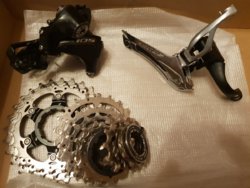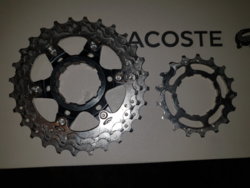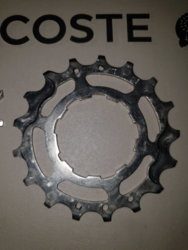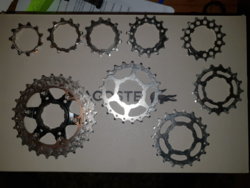You are using an out of date browser. It may not display this or other websites correctly.
You should upgrade or use an alternative browser.
You should upgrade or use an alternative browser.
105 5800 bits sold
- Thread starter broady
- Start date
Page may contain affiliate links. Please see terms for details.
Yellow Saddle
Guru
- Location
- Loch side.
Toss the cassette. I can see from the photo that it is worn and will not mesh with a new chain.
Cassette is binned
How can you tell @Yellow Saddle ?
The chain that was on the bike it came on wasn't excessively worn and although I only did a 7 mile ride on that set up it didn't slip or skip.
I only want to know for the future as I've taken your advice on this one
How can you tell @Yellow Saddle ?
The chain that was on the bike it came on wasn't excessively worn and although I only did a 7 mile ride on that set up it didn't slip or skip.
I only want to know for the future as I've taken your advice on this one
Yellow Saddle
Guru
- Location
- Loch side.
If you can quickly rescue it from the bin and take a better photo, I'll show you how I can see.
I need a good photo of sprocket No 6 (counting from smallest up) as well as sprocket number last (biggest one). Put them next to each other on a flat surface and take the photo head-on. I'll then show you what to look for.
If you lay them all out flat and take another photo head-on, I'll point out which gears are your favourite ones too. So far you have spent most time in No 6.
I need a good photo of sprocket No 6 (counting from smallest up) as well as sprocket number last (biggest one). Put them next to each other on a flat surface and take the photo head-on. I'll then show you what to look for.
If you lay them all out flat and take another photo head-on, I'll point out which gears are your favourite ones too. So far you have spent most time in No 6.
Yellow Saddle
Guru
- Location
- Loch side.
OK, thanks for the pictures.
First things first, terminology:
Any "gear" that meshes with a chain is called a sprocket.
On a bicycle there are two types of sprockets: 1. driven sprockets (rear sprockets) and driving sprockets (front sprockets).
These two work under completely different modes and their wear patterns and symptoms are completely different. We'll deal with driven sprockets only.
When there are several of them stacked adjacently, we call it a cassette. A cassette has multiple sprockets.
Each sprocket has several cogs. A cog is a tooth on a sprocket, not an entire sprocket.
Each cog has a tip and a root. The root is the valley at the bottom of the sprocket and the tip is, well, the tip.
A sprocket has a specific pitch and the pitch is the distance from the centre of one tip to the centre of an adjacent tip. On bicycles the pitch is 1/2 inch but on chainsaws and military tanks the pitch is obviously different.
The chain that meshes with the sprocket has the same pitch as the sprocket, i.e. 1/2 inch. As the chain wears, it elongates so that the pitch changes in length. It becomes longer. To confuse things a bit, a bicycle chain only elongates in every second link but the definition of a link is a different story for a different day.
Therefore, as the chain wears, it becomes longer and it no longer matches the pitch of the sprocket it works with. This causes the chain to no longer fall naturally down to the root of each cog as the sprocket turns, but rides higher up. It finds a better mesh higher up because the cogs radiate outwards due to the roundness of the sprocket.
As the chain starts to lift, a roller in the chain only bears on one cog, no longer on three or four. This causes excessive wear at the back of the cog (the trailing edge).
This rapidly wears a pocket in the trailing edge to the extent that the shape of the cog in your favourite "gear" no looks different from a gear that you don't use all that often.
The look isn't all that obvious to the untrained eye but with a bit of practice, you can quickly recognise it. Here's what to look for: look at the root of the cog. On a new sprocket the root forms a perfect semi-circle. In other words, if you ware to patch a few roots together, you'll get a perfect circle. On a worn sprocket the root elongates and gets a long, flat bottom that no longer forms a good circular section but rather a sort of elliptical section.
Here's a photo of a new sprocket.
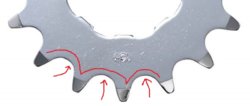
Note the nice round and compact root.
Now compare that to the roots on your top gear (biggest sprocket) and the number 6 one that's pictured along. Can you see the difference in shape? If you look at the root at the 25-to position on that single sprocket you can see it clearly.
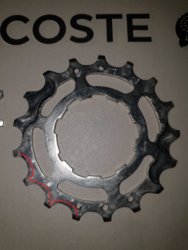
Note the elongated roots. Don't look at the shape of my red lines, that's deceiving. I can't draw well with a mouse.
First things first, terminology:
Any "gear" that meshes with a chain is called a sprocket.
On a bicycle there are two types of sprockets: 1. driven sprockets (rear sprockets) and driving sprockets (front sprockets).
These two work under completely different modes and their wear patterns and symptoms are completely different. We'll deal with driven sprockets only.
When there are several of them stacked adjacently, we call it a cassette. A cassette has multiple sprockets.
Each sprocket has several cogs. A cog is a tooth on a sprocket, not an entire sprocket.
Each cog has a tip and a root. The root is the valley at the bottom of the sprocket and the tip is, well, the tip.
A sprocket has a specific pitch and the pitch is the distance from the centre of one tip to the centre of an adjacent tip. On bicycles the pitch is 1/2 inch but on chainsaws and military tanks the pitch is obviously different.
The chain that meshes with the sprocket has the same pitch as the sprocket, i.e. 1/2 inch. As the chain wears, it elongates so that the pitch changes in length. It becomes longer. To confuse things a bit, a bicycle chain only elongates in every second link but the definition of a link is a different story for a different day.
Therefore, as the chain wears, it becomes longer and it no longer matches the pitch of the sprocket it works with. This causes the chain to no longer fall naturally down to the root of each cog as the sprocket turns, but rides higher up. It finds a better mesh higher up because the cogs radiate outwards due to the roundness of the sprocket.
As the chain starts to lift, a roller in the chain only bears on one cog, no longer on three or four. This causes excessive wear at the back of the cog (the trailing edge).
This rapidly wears a pocket in the trailing edge to the extent that the shape of the cog in your favourite "gear" no looks different from a gear that you don't use all that often.
The look isn't all that obvious to the untrained eye but with a bit of practice, you can quickly recognise it. Here's what to look for: look at the root of the cog. On a new sprocket the root forms a perfect semi-circle. In other words, if you ware to patch a few roots together, you'll get a perfect circle. On a worn sprocket the root elongates and gets a long, flat bottom that no longer forms a good circular section but rather a sort of elliptical section.
Here's a photo of a new sprocket.

Note the nice round and compact root.
Now compare that to the roots on your top gear (biggest sprocket) and the number 6 one that's pictured along. Can you see the difference in shape? If you look at the root at the 25-to position on that single sprocket you can see it clearly.

Note the elongated roots. Don't look at the shape of my red lines, that's deceiving. I can't draw well with a mouse.
Last edited:
Yellow Saddle
Guru
- Location
- Loch side.
That's recognising wear by shape only. I'll find some photos of other wear facets and post those as well.
Not all sprocket teeth look alike. You have to focus on the ones without shifting chamfers and ramps. Those also deceive the eye.
Not all sprocket teeth look alike. You have to focus on the ones without shifting chamfers and ramps. Those also deceive the eye.
Thanks for that @Yellow Saddle
I'm going to look at s new cassette later when I get the chance.
I'm going to look at s new cassette later when I get the chance.
davidphilips
Phil Pip
- Location
- Onabike
That's recognising wear by shape only. I'll find some photos of other wear facets and post those as well.
Not all sprocket teeth look alike. You have to focus on the ones without shifting chamfers and ramps. Those also deceive the eye.
Very interesting Yellow Saddle thank you, could never tell just by looking now i will be looking at all my bikes cassettes , thank you.
Johnno260
Guru
- Location
- East Sussex
Yes thanks I know what to look for as well.
Similar threads
- Replies
- 0

